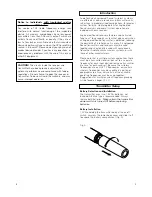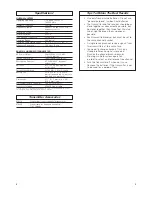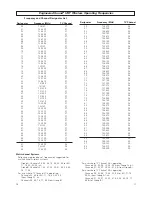
9
Tips To Obtain The Best Results
• Use only fresh alkaline batteries. Do not use
“general purpose” (carbon-zinc) batteries.
• The transmitter and the receiver should be as
close together as conveniently possible, but
no closer together than three feet. Maintain
line-of-sight between them whenever
possible.
• Each transmitter/receiver pair must be set to
the same channel number.
• A single receiver cannot receive signals from
two transmitters at the same time.
• You need to change channels 1) when a
strong interference signal is received,
2) when the channel breaks down, or
3) during multiple-system operation
in order to select an interference-free channel.
• Turn the transmitter off when not in use.
Remove the batteries if the transmitter is not
to be used for a period of time.
8
Specifications
†
OVERALL SYSTEM
Operating Frequency
UHF band, 728.125 to
740.500 MHz
Number of Channels
100 total
Frequency Stability
±0.005%, Phase Lock Loop
frequency control
Modulation Mode
FM
Normal Deviation
±5 kHz
Tone Squelch Frequency
32.768 kHz
Operating Range
300' typical
Operating Temperature Range
41° F (5° C) to 113° F (45° C)
Frequency Response
100 Hz to 15 kHz
ESW-T214 HANDHELD TRANSMITTER
RF Power Output
50 mW Max (H: 10 mW;
L: 5 mW, typical)
Spurious Emissions
Under federal regulations
Microphone Element
A-T Hi-ENERGY
®
dynamic,
unidirectional
Batteries
Two 1.5V AA type alkaline,
not included
Current Consumption
H: 105 mA; L: 95 mA, typical
Battery Life
H: 16 hours; L: 18 hours,
typical (depending on battery
type and use pattern)
Dimensions
2.11" (53.5 mm) dia. x 9.41"
(239.0 mm) long
Net Weight (without batteries)
10.4 oz (295 grams)
Accessory Included
AT8456 stand clamp
† In the interest of standards development, A.T.U.S. offers full details on its test
methods to other industry professionals on request.
Transmitter Accessories
AT8114
Foam windscreen for handheld transmitter.
AT8456
Stand clamp for handheld transmitter,
5
/
8
"-27 threads.

























